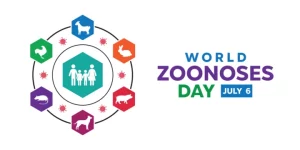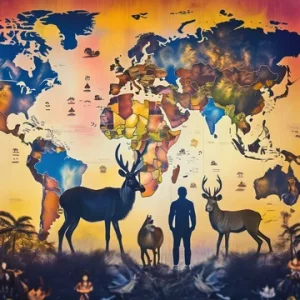Uttam Saikia and Jyoti B. Dutta
 Humanity has just endured COVID-19 and is still recovering from the societal and economic cost it has imposed on us. What started as a viral respiratory infection in the Chinese city of Wuhan towards the end of 2019, spread at an unprecedented rate globally and by March, 2020 was declared as a global pandemic by the World Health Organization (WHO). The source of this infection is still debated but it is believed that the coronavirus might have jumped to humans from an infected animal although the exact identity of this animal source is anybody’s guess.
Humanity has just endured COVID-19 and is still recovering from the societal and economic cost it has imposed on us. What started as a viral respiratory infection in the Chinese city of Wuhan towards the end of 2019, spread at an unprecedented rate globally and by March, 2020 was declared as a global pandemic by the World Health Organization (WHO). The source of this infection is still debated but it is believed that the coronavirus might have jumped to humans from an infected animal although the exact identity of this animal source is anybody’s guess.
 Any infectious disease that jumps from vertebrate animals to humans is called zoonosis or zoonotic disease. The history of humankind is replete with zoonotic pandemics. The ‘Plague of Athens’ during 429–426 BCE which killed one quarter of the population of Athens; the ‘The Black Death’ or plague pandemic in Europe during 1346–1352 CE wiping out the entire population in certain regions; the ‘Spanish Flu’ during 1918-1920 killing over 20 million people in Europe, and very recently, Covid-19 pandemic with over six million global deaths are stark reminders of how fragile the human race is. WHO has listed over 200 zoonoses involving a variety of bacteria, viruses, parasites or fungi responsible for a significant portion of human diseases.
Any infectious disease that jumps from vertebrate animals to humans is called zoonosis or zoonotic disease. The history of humankind is replete with zoonotic pandemics. The ‘Plague of Athens’ during 429–426 BCE which killed one quarter of the population of Athens; the ‘The Black Death’ or plague pandemic in Europe during 1346–1352 CE wiping out the entire population in certain regions; the ‘Spanish Flu’ during 1918-1920 killing over 20 million people in Europe, and very recently, Covid-19 pandemic with over six million global deaths are stark reminders of how fragile the human race is. WHO has listed over 200 zoonoses involving a variety of bacteria, viruses, parasites or fungi responsible for a significant portion of human diseases.
 Major sources of zoonoses: Although all vertebrate animals are potential sources of zoonoses, mammals and birds are responsible for a majority of them. For example, rabies is one such ancient and dreaded disease of mankind, mostly ending in death. Depending on the geographic region, it is transmitted by a number of animals like bats, dogs, foxes, jackals, mongooses, marmoset and raccoons. The human immunodeficiency virus causing AIDS in humans likely originated from a closely related simian immunodeficiency virus circulating in chimpanzees and gorillas in West Central Africa. However, HIV1, the main causative agent of AIDS later on evolved into an independent human-specific lineage, permanently circulating among humans. Similarly, Ebola Virus Disease, a severe form of hemorrhagic fever occurring in the Central and West African countries is reported to have a natural reservoir in fruit bats. Many subtypes of avian influenza virus circulate among birds especially waterfowl and shorebirds responsible for occasional human infections, too. The severe swine flu pandemic in 2009 was identified to have been caused by a H1N1 subtype of Influenza Virus that emerged due to recombination events among the existing avian, swine and human influenza virus causing enormous human fatalities and economic loss.
Major sources of zoonoses: Although all vertebrate animals are potential sources of zoonoses, mammals and birds are responsible for a majority of them. For example, rabies is one such ancient and dreaded disease of mankind, mostly ending in death. Depending on the geographic region, it is transmitted by a number of animals like bats, dogs, foxes, jackals, mongooses, marmoset and raccoons. The human immunodeficiency virus causing AIDS in humans likely originated from a closely related simian immunodeficiency virus circulating in chimpanzees and gorillas in West Central Africa. However, HIV1, the main causative agent of AIDS later on evolved into an independent human-specific lineage, permanently circulating among humans. Similarly, Ebola Virus Disease, a severe form of hemorrhagic fever occurring in the Central and West African countries is reported to have a natural reservoir in fruit bats. Many subtypes of avian influenza virus circulate among birds especially waterfowl and shorebirds responsible for occasional human infections, too. The severe swine flu pandemic in 2009 was identified to have been caused by a H1N1 subtype of Influenza Virus that emerged due to recombination events among the existing avian, swine and human influenza virus causing enormous human fatalities and economic loss.  Kerala has reported several outbreaks of highly infectious Nipah virus in recent times with many fatalities. Fruit bats are the natural reservoir of this virus. Animals and birds, including reptiles like snakes and lizards are carriers of pathogenic bacteria causing salmonellosis, commonly known as typhoid or food-poisoning in humans.
Kerala has reported several outbreaks of highly infectious Nipah virus in recent times with many fatalities. Fruit bats are the natural reservoir of this virus. Animals and birds, including reptiles like snakes and lizards are carriers of pathogenic bacteria causing salmonellosis, commonly known as typhoid or food-poisoning in humans.
Zoonotic transmission: Humans acquire zoonotic infections via a variety of routes i.e. through
direct contact with infected animal’s body fluids or excreta, respiratory droplets of diseased animals, consumption of contaminated food, improperly cooked meat, raw milk, exposure to contaminated soil, water or waste materials beside insects like mosquitoes, fleas, and ticks. Rabies is primarily transmitted through bites and scratches of rabid animal or saliva contact on broken skin. Scientists have documented fruit bats as a natural reservoir of many deadly viruses like Ebola and Nipah leading to spillover events (outbreaks) in man after coming in contact with them. Once the first person gets infected, human to human transmission becomes easy through contact with contaminated blood or body fluids or even the body of a deceased person. Regular Nipah outbreaks in Bangladesh and India are mostly mediated through consumption of fruits or date palm juice contaminated with faeces and urine of fruit bats. On the other hand, diseases like Japanese Encephalitis (JE) and Scrub Typhus are transmitted by vectors like mosquitoes and ticks or mites. Rodents are natural hosts of Scrub Typhus bacteria. Certain species of mites called chiggers feed on infected rodents and then pass on the pathogen to human beings causing serious illness. Likewise, pigs and birds like egrets and herons are natural reservoirs of JE virus which is transmitted to humans through mosquito bites.
Emerging zoonotic diseases: The threat of zoonoses continues to lurk over mankind, in fact, it is more potent now, than ever. As per the WHO, 60 percent of the emerging infectious diseases reported globally are zoonoses. Seventy five percent of the new human pathogens reported in the last three decades are of animal origin. Emerging zoonotic diseases are those caused by new or previously unknown pathogens, appearing in places or in species in which the disease was not reported earlier. Hendra, Nipah, Marburg, Ebola, MERS-CoV and SARS-CoV-1 and 2 are some of the well documented zoonotic viruses identified in relatively recent times. These are pathogens of great concern due to their high infectivity and virulence.
Although scientists are yet to unravel the precise mechanisms regarding how the zoonotic pathogens perpetuated in nature and how they jump across species barriers to infect human beings, the consensus is that ecological factors play a vital role in the transmission and occurrences of zoonotic diseases. Without a doubt, massive ecological changes globally have facilitated a much higher degree of animal-human interactions than was ideally expected.
Activities like expansion of agriculture into forest land, mining, tourism and exploration have exposed livestock and humans to the pathogens maintained in the wildlife. Large scale illegal wildlife trade and their trans-boundary movement also increased the odds of humans catching a number of unwelcome microbes. Improved state of global connectivity and climate-change driven factors ensure that once the human to human infection sets in, it snowballed rapidly to assume the insurmountable proportion that was witnessed during the Covid-19 pandemic.
Pressing need for a coordinated global response: No matter where it originates, zoonotic infections are a concern to global health security owing to its trans-boundary potential. Recently, Sir Patrick Vallance, the former chief scientific adviser to the government of UK issued a warning that another pandemic is inevitable and called upon the government to prioritise preparedness. In the World Economic Forum meeting at Davos in January, 2024, the WHO issued a stark warning that the world could face a pandemic 20 times worse than Covid in the future. Coined Disease X, this global pandemic could result from a novel pathogen rather than any existing diseases and called for a global synergistic strategy to contain or manage the outbreak of the hypothetical pandemic.
Although a lot of complex data and simulation tools are being used, it is a matter of debate whether scientists can actually predict and prevent the next pandemic. However, preparedness is the key for facing any unforeseen eventuality. The recent pandemic has brought forth the vulnerability of our health system. Strengthening the public health system and investing in research and development for producing and deployment of effective vaccines and medicines can be a key response of the global community to contain any future pandemic. Risk assessment of any infections, its spread and mutations, through monitoring of disease trends are invaluable tools for pandemic preparedness. Unfortunately, disparity in surveillance and response capacity of individual countries hinders these global efforts. Therefore, it is essential that all countries gear up for collaborative strategies to combat such events effectively.
Uttam Saikia is a scientist working in the North Eastern Regional Centre, Zoological Survey of India, Shillong & Professor Jyoti B Dutta is the Head of the Department Veterinary Epidemiology & Preventive Medicine, College of Veterinary Science, Guwahati.
The views expressed are personal



